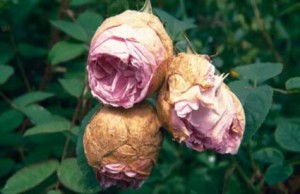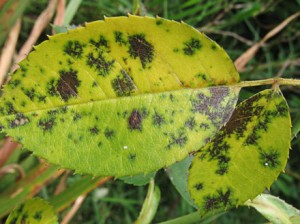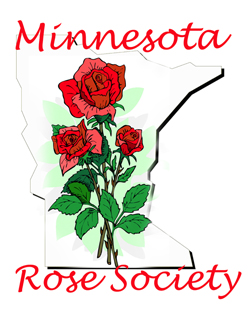Rose Diseases
 There are many diseases that attack roses. Fortunately there are only a few that are widespread in the upper Midwest.
There are many diseases that attack roses. Fortunately there are only a few that are widespread in the upper Midwest.
Black Spot, Powdery Mildew, Downy Mildew, Rust and Anthracnose are the most common diseases and will be the subject of this guide.
The following is an educational list of things to look for and try to prevent while caring for your roses. If you have any questions about any of these rose diseases, please reach out to the Minnesota Rose Society and we will try and help you diagnose the problem.
Black Spot
 Source: Fungus Diplocarpon rosae.
Source: Fungus Diplocarpon rosae.
Identification: Mostly black, circular spots that appear on the upper side of leaf, often surrounded by a yellowing of the leaf. The yellowing continues until leaf drop. Black spot spores are spread by splashing water with the disease usually starting at the bottom of the bush. A serious infection can completely defoliate a bush. Optimum conditions for infection and disease development are temperatures of 75°F to 85°F with relative humidity of 85% and six or more hours of leaf wetness.
Control: Remove and destroy diseased foliage and canes. Regular applications of preventative fungicides such as Immunox™ , Funginex™ (triforine), Daconil™ (chlorothalinil) or Mancozeb.
Powdery Mildew
Source: Sphaerotheca pannosa var. rosa
Identification: Powdery mildew appears as small white patches of dust on leaves, stems, buds and flowers. Infection occurs at temperatures of 70°F to 80°F with humidity of 90-99%. Powdery patches appear usually a week after infection. Powdery Mildew is rarely present in hot, dry weather.
Control: Remove and destroy diseased foliage and canes. Preventative fungicides such as Immunox™ , Funginex™ (triforine), Banner Maxx™, Daconil (chlorothalinil), sulfur or copper based fungicides are recommended during the growth season once leaves have begun to develop. In the Fall, an application of lime sulfur prior to final winter protection may help in controlling powdery mildew in the spring.
Downy Mildew
Source: Peronospora sparsa
Identification: Symptoms occur primarily on leaf , canes and peduncles. Large red to brown angular spots surrounded by yellow margins with occasional red leaf edges.. Often confused with black spot. Appears during periods of cool, humid weather. Humidity below 85% and temperatures above 80°F tend to suppress disease development.
Control: Aliette, Heritage™ and Phyton™ 27.
Rust
Source: Phragmidium (several species)
Identification: Small orange pustules normally develop on the underside of leaves and other plant parts at temperatures of 65° to 70°F with continuous moisture of two to three hours. There is little spread of the disease during the summer months. In late summer infected plants often develop black structures that overwinter on canes and fallen leaves.
Control: Remove and destroy diseased foliage and canes. Regular applications of preventative fungicides such as Immunox™ , Funginex™ (triforine), or sulfur will adi in control. In the Fall, an application of lime sulfur prior to final winter protection may help in controlling Rust in the spring.
Anthracnose
Source: Elsinoe rosarum
Identification: Initial infection usually starts out with small black spots, easily confused with black spot. As the disease continues the spots become purple to brown with a red or purple margin. Yellowing with defoliation can occur in severe infections. Anthracnose typically occurs during prolonged periods of rainy weather.
Control: Remove and destroy diseased foliage and canes. Regular applications of preventative fungicides such as Immunox™ , Funginex™ (triforine), Daconil™ (chlorothalinil) or Mancozeb.
This information is provided to you by the Minnesota Rose Society.


